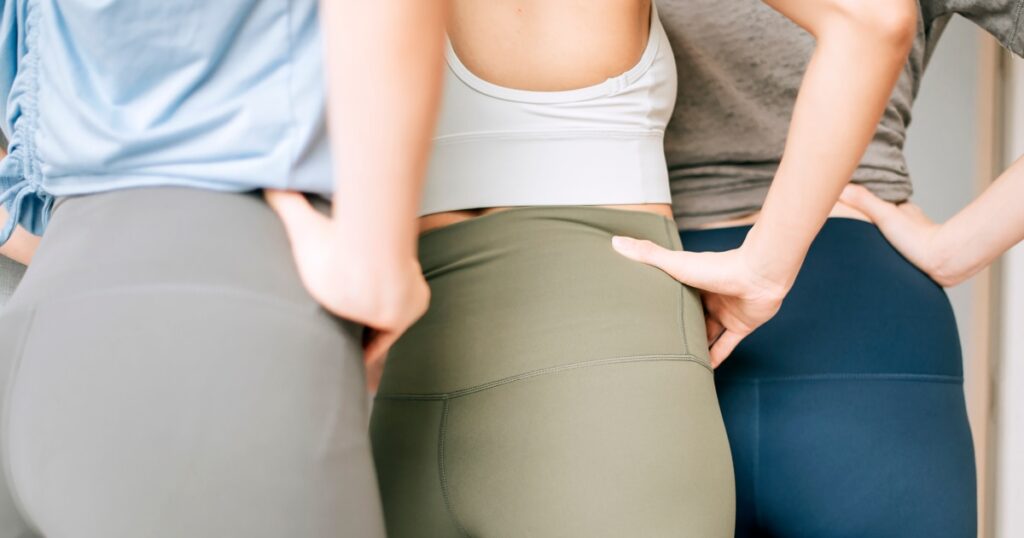“Hip dips” is a term popularized on social media to describe the natural indentations or dips where the hips meet the outer thighs. Also called “violin hips,” hip dips are yet another example of a trendy buzzword to point out a specific physical feature.
It seems like every other week the internet is calling attention to another completely normal part of the body — from buccal fat to thighbrows, bikini bridges and everything in between.
Hip dips have become an increasingly popular topic in recent years, largely thanks to platforms like TikTok. Many fitness influencers promote workouts and even diets that promise to get rid of hip dips, while other creators demonstrate how to hide hip dips with certain clothing.
At the same time, many have turned the hip dip obsession into a body positive movement, encouraging others to confidently embrace their body structure — curves, dips and all.
So what are hip dips, why do some people have them and is there actually any way to get rid of them? We spoke to experts to set the record straight.
What are hip dips?
Hip dips refer to the slight indentations of either side of the outer thigh, which makes it look like there’s a dip that curves inward at the tops of the thighs right below the hips, Stephanie Mansour, TODAY fitness contributor, tells TODAY.com.
Many people refer to these natural indentations as “violin hips” because the shape they give the midsection, which may resemble the outer curves of the body of the string instrument.
While it isn’t exactly clear where or when the nickname “hip dips” originated, it is not a medical term or a health condition, experts emphasize. Hip dips are simply a variation in a person’s body shape.
What causes hip dips?
Generally speaking, hip dips are caused by a combination of genetics and the shape and structure of the hip bones, or the pelvis, and top of the femur bones. “It’s literally how you’re born, it’s anatomical,” Katie Lawton, an exercise physiologist at the Cleveland Clinic, tells TODAY.com.
The part of the body that sticks out above the hip dip is called the iliac crest, which is the curved outer area of the ilium bone, the uppermost part or “wings” of the pelvis, Dr. Julia Iafrate, a sports medicine physician at NYU Langone Health, tells TODAY.com. The iliac crest is the most prominent part of the pelvis, Iafrate adds; it’s the bone you feel when you place your hands on your waist and push down.
Beneath the hip dip is the top of the thighbone or femur (called the greater trochanter), which makes up the widest and most prominent part of our hips, says Iafrate. In between the ilium and femur are muscles and fat, which curve slightly inward to create an indentation or dip visible from the outside.
“The more broad or wide the ilium is compared to the greater trochanter, that is going to make somebody potentially have hip dips,” says Iafrate. Additionally, a person with more prominent hip dips may have higher hip bones or the head of the femur bone may be at a downward angle, says Lawton. The angle may cause the muscle and fat to sink inward more, causing a more pronounced indentation or dip.
These indentations are not caused by the muscle or fat in that area, Mansour notes, but rather, a person’s skeletal build. The extent to which hip dips are visible can be attributed to a person’s genetics and anatomical structure, Lawton notes, not weight.
Some people have this anatomical feature and others don’t — just like other parts of the body may be longer, shorter or shaped differently depending on a person’s skeleton, the experts note.
Are hip dips normal?
Hip dips are absolutely normal, the experts emphasize. “It’s just someone’s bony anatomical structure,” says Lawton, adding that hip dips aren’t considered an abnormality compared to what “standard” or “ideal” hips look like. Hips with dips are normal hips.
Contrary to much of the language around hip dips on social media, there is nothing wrong or bad about them — they’re just another natural part of the body. “Hip dips are beautiful,” Iafrate adds.
“Basically, it’s a genetic difference in some people that is not medically concerning whatsoever,” says Iafrate.
Hip dips are not harmful in any way, but obsessing over hip dips and trying to get rid of them could become harmful to one’s body image or mental health, the experts note.
Despite, this, “how to get rid of hip dips” remains a commonly searched question, and there are countless videos and guides online promising to help people get rid of hip dips. Is this actually possible?
Can you get rid of hip dips?
Simply put, no, experts say. “I don’t believe there is anything you can do physically to change any type of hip dip,” says Lawton.
Since hip dips are caused by the bony anatomical structure, building muscle or losing fat will not get rid of them, Mansour says. There’s really no exercise or diet regimen that can “fix” hip dips or fill in this indentation, no matter what you see online, the experts emphasize.
Spot training or spot reduction — the idea that exercises targeting a specific area of the body can cause muscle gain or fat loss in only that part of the body — not the answer either, the experts note. “It’s not possible,” says Iafrate.
“I’m never big into spot reduction. … You can do as many exercises as you want in one area, but your body’s going to decide how it’s going to look, essentially because of how it’s anatomically structured or where your weight generally sits,” says Lawton.
However, there are ways to build muscles in the lower body and tone the hip and thigh muscles, if that is your goal. “You can build an overall rounder or larger or more muscular glute to help create a different look there … and you can increase muscle mass in the lower body,” says Mansour.
Strengthening the muscles around the hip dips, such as the glutes and hamstrings, has other health benefits, the experts note. “Anything related to hip strengthening is very important when we’re talking about back pain, knee pain and hip pain,” says Lawton.
Hip strength is also important for basic strength training, running and overall health, Lawton adds.
Here are some good exercises to build strength and tone the lower body, if that’s what you’re looking for:
Strength exercises to tone lower body
- Squats
- Lunges
- Side lunges
- Side-lying leg lift
- Bridges
- Hip thrust
- Standing leg lifts to the side
- Romanian deadlift
Cardio exercises for overall fat reduction
- Jump squats
- Jogging
- Walking on an incline
- Jumping jacks
Whichever exercise routine you choose, Lawton emphasizes that consistency matters if you’re trying to reach a certain goal.
Always talk to your doctor or physical therapist before starting a new exercise, especially if you have a history of injuries, hip or knee surgeries or other orthopedic issues, the experts note.
Hip dips surgery
A google search for “hip dips surgery” yields countless results about elective procedures, as well as injections, that promise to change the appearance of hip dips. These include fat grafting, implants and dermal fillers.
While the experts did not comment on any specific procedures, they emphasize that hip dips are normal and do not need to be treated. Additionally, any plastic or cosmetic surgery comes with risks and results can vary greatly among patients.
Read the full article here












